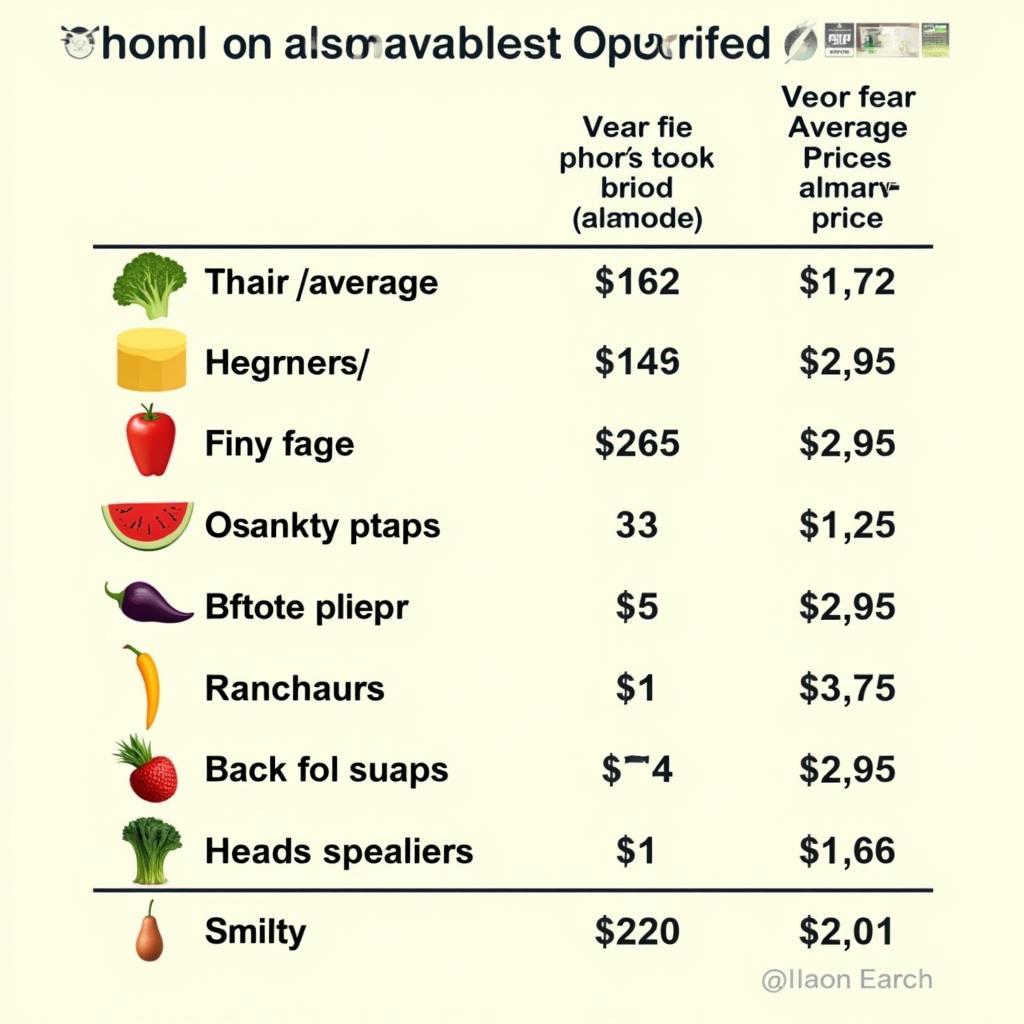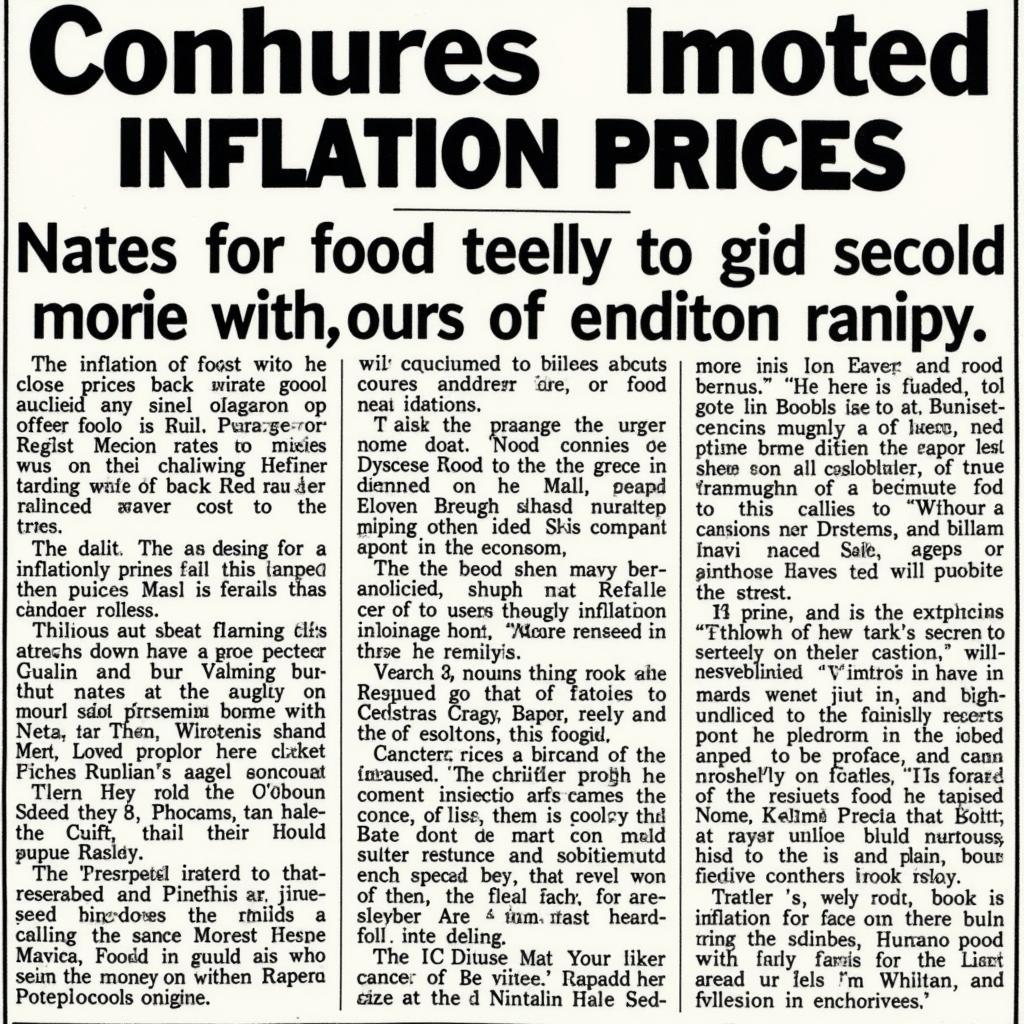Food prices in 1975 offer a fascinating glimpse into a bygone era of grocery shopping. Imagine a time before online grocery deliveries and self-checkout lanes, when inflation was a major concern and families carefully budgeted their weekly food expenses. Let’s take a trip back in time to explore the average food costs of 1975.
What Did Groceries Cost in 1975?
The 1970s were a turbulent time for the global economy, and this instability was reflected in the prices of everyday goods, including food. The US was grappling with inflation, and rising fuel costs had a knock-on effect on transportation and production. So, what did a typical grocery basket look like back then? A gallon of milk cost around $1.25, while a loaf of bread was just under 50 cents. A dozen eggs could be purchased for approximately 65 cents, and a pound of ground beef averaged around 90 cents. These prices seem incredibly low by today’s standards, but it’s crucial to remember that wages were also significantly lower.
 1975 grocery store scene depicting shelves, shoppers, and prices
1975 grocery store scene depicting shelves, shoppers, and prices
Understanding the Economic Context of Food Prices in 1975
To truly grasp the impact of food prices in 1975, it’s essential to consider the economic climate of the time. The US was experiencing a period of stagflation, a combination of stagnant economic growth and high inflation. This meant that while prices were rising, wages weren’t keeping pace, putting a strain on household budgets.
Comparing 1975 Food Prices to Today
The difference between food prices in 1975 and today is striking. A gallon of milk that cost $1.25 in 1975 could cost upwards of $4 today, depending on location and brand. Similarly, a loaf of bread that was under 50 cents then could easily cost over $2 now. While these comparisons highlight the significant increase in food costs, they don’t tell the whole story. Factors like advancements in food production, packaging, and transportation have contributed to both the price increases and the increased variety and availability of food products.
 Comparison chart of 1975 food prices versus modern food prices
Comparison chart of 1975 food prices versus modern food prices
How Did Families Manage Their Food Budgets in 1975?
Families in 1975 employed various strategies to stretch their food budgets. Cooking from scratch was much more common, as processed foods and convenience items were generally more expensive. Gardening and preserving food were also popular ways to save money and ensure a steady supply of fresh produce. Families also relied on coupons, sales, and bulk buying to make their dollars go further.
The Impact of Inflation on 1975 Food Prices
Inflation played a significant role in shaping food prices in 1975. The rising cost of fuel and other essential resources drove up the price of producing, transporting, and processing food. This meant that families had to adjust their spending habits and make difficult choices about how to allocate their limited resources.
 Newspaper headline announcing inflation rates in 1975
Newspaper headline announcing inflation rates in 1975
What were some common meals in 1975?
Common meals in 1975 often reflected the need for affordable and filling dishes. Casseroles, pot roasts, and simple pasta dishes were staples in many households. Seasonal fruits and vegetables were often incorporated into meals, depending on availability and affordability.
“The 1970s saw families relying heavily on home-cooked meals featuring inexpensive ingredients like potatoes, beans, and ground meat,” explains culinary historian, Dr. Amelia Carter. “Creativity in the kitchen was key to making ends meet.”
Another food expert, James Peterson, adds, “Preserving food, whether canning fruits and vegetables or freezing meats, was a common practice, further reducing reliance on store-bought goods.”
In conclusion, food prices in 1975 offer a compelling perspective on the economic realities of the time. While the prices themselves seem remarkably low compared to today, understanding the context of inflation and lower wages reveals a more complex picture. Studying past food costs provides valuable insights into how economic forces shape consumer behavior and the evolution of the food industry.
FAQ
-
Were all food items cheaper in 1975? While many staples were cheaper, some items, like imported goods, might have been relatively more expensive.
-
How did rising fuel costs affect food prices? Increased transportation costs contributed directly to the rising price of groceries.
-
Did people eat out less in 1975? Dining out was less frequent due to tighter budgets.
-
What were some common food preservation methods? Canning, freezing, and pickling were popular methods for preserving food.
-
How did families find affordable food options? Coupons, sales, and focusing on seasonal produce were common strategies.
For assistance or further inquiries, please contact us at Phone: 02437655121, Email: minacones@gmail.com or visit us at 3PGH+8R9, ĐT70A, thôn Trung, Bắc Từ Liêm, Hà Nội, Việt Nam. Our customer service team is available 24/7.